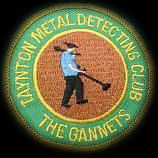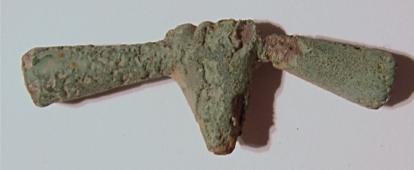
Clay Pipes
Introduction
Plain Bowls
Decorated Bowls
Decorated Whole
Pipe Stamps
Elmbridge Road
Taynton Metal Detecting Club
The Gannets
Introduction to Clay Pipes
Clay Tobacco Pipes in Gloucestershire
'The clay pipe is perhaps the most commonly found object from the recent past. Following the introduction of tobacco into England in the latter half of the sixteenth century, clay pipes were rapidly adopted throughout the country. By 1619 clay pipes were being manufactured in Bristol, pipes of this period being quite common in Gloucestershire. Throughout England wherever man has lived or worked clay pipe fragments can be found. They are of great use to the post medieval archaeologist for their dating significance and of considerable interest to the amateur historian or collector. Due to their fragile nature they were quickly broken and discarded, lending themselves perfectly to a pattern of regular stylistic development which is key to their dating. The first practical bowl form typology put forward by Adrian Oswald in 1951, has been the starting point for several subsequent regional studies. With the exception of certain dominant production centres, clay pipes rarely travelled more than a days packhorse journey from their place of manufacture and inevitably local variations on the prevailing styles developed. Gloucester, by virtue of its position on the Severn was constantly exposed to the influence of both Bristol and Broseley, two of the most important production centres in the country, so it is to be expected that echoes from both are to be found in the local products. It is doubtful whether pipemaking began in Gloucester before the middle of the seventeenth century, pipes from the first half being relatively scarce and there being no recorded pipemaker before 1664.
Taken from Clay Tobacco Pipes in Gloucestershire - Dr Allan Peacey 1977. Dr Allan Peacey is professor of ceramics at Beaudesert College, Stroud. Allan is a highly respected member of the Society for Clay Pipe Research , recognised nationally and internationally for his research on pipes and of pipe kiln manufacture. Allan currently heads up the Pipe Aston Project .

Club Member, Andy Frape
I began collecting at the tender age of 10 when my father accepted a load of top soil for his allotment. The soil came from the Longford Inn, Gloucester a former coaching Inn. While digging it over I used to pull out old pennies, rubber bottle stoppers, snuff boxes and pipes. It was the pipes that fascinated me; the first I found had a football on it. Most had the manufacturer's name on the stem - H.Dewy & Co Gloster. In my early teens I was to be found roaming the building sites in Gloucester, sifting through service trenches and spoil heaps, one such site in Westgate Street produced over 200 early bowls, many marked on the base of the bowl. When I took these to the nearby Folk Museum, they put me in touch with Dr Peacey who took an interest in my collection even then. After a break of 10 years or so I began visiting Gloucester building sites again and recording my finds for the Society for Clay Pipe Research (SCPR) where I display them at the annual conference. Since joining the Taynton MDC, I have been fortunate to record some of the club collection as well as identify and record current finds.

Bronze pipe tamper.
Hand holding Scroll.
Newent.